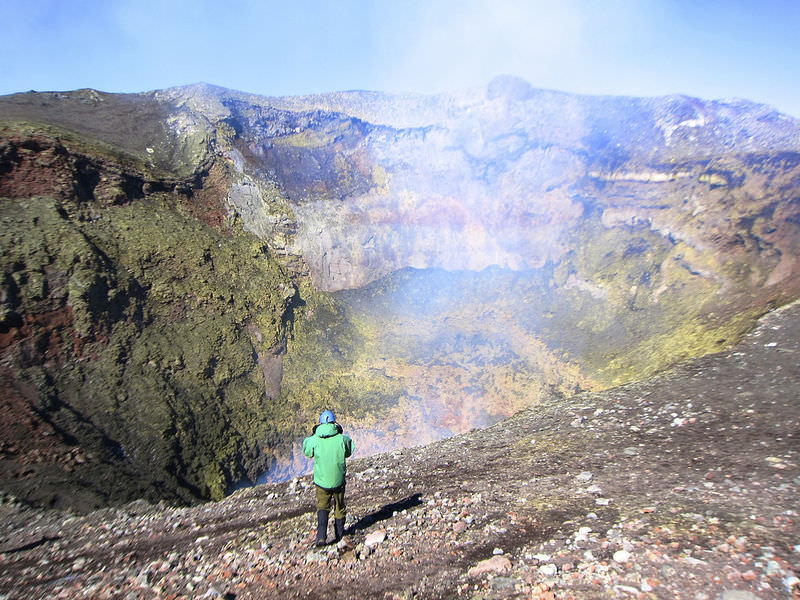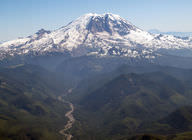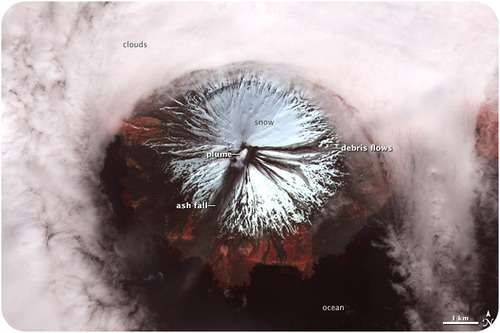7.7预测火山喷发
章节大纲
-
What is one of the deadliest science jobs?
::最致命的科学工作是什么?No one can predict exactly when a volcanic eruption will take place. There are clues, but no one knows exactly when. Sometimes a volcano will erupt when scientists are studying it. Volcanologists have a high fatality rate among scientists because forecasting eruptions is so difficult.
::没有人能够准确预测火山爆发何时会发生。 有一些线索,但没人知道何时会爆发。 有时,当科学家研究火山时,火山就会爆发。 火山学家在科学家中死亡率很高,因为预测火山爆发非常困难。Predicting Volcanic Eruptions
::预测火山爆发Volcanic eruptions can be devastating, particularly to the people who live close to . Volcanologists study volcanoes to be able to predict when a volcano will erupt. Many changes happen when a volcano is about to erupt. Even so, eruptions are very difficult to predict.
::火山爆发可能是毁灭性的,特别是对于生活在火山附近的人来说。火山学家研究火山,以便预测火山何时会爆发。火山即将爆发时会发生许多变化。即便如此,火山爆发也很难预测。History of Volcanic Activities
::火山活动史Scientists study a volcano’s history to try to predict when it will next erupt. They want to know how long it has been since it last erupted. They also want to know the time span between its previous eruptions. Scientists watch both active and dormant volcanoes closely for signs that show they might erupt.
::科学家们研究火山的历史,试图预测火山何时会再次喷发。 他们想知道火山自上次喷发以来已经持续了多久。 他们还想知道火山前几次喷发之间的时间间隔。 科学家们仔细观察活火山和休眠火山的爆发迹象。Mount Rainier in Washington State is currently dormant. The volcano could, and probably will erupt again.
::华盛顿州的莱尼埃山目前处于休眠状态。 火山可能、也可能再次爆发。Earthquakes
::地震地震may take place every day near a volcano. But before an eruption, the number and size of earthquakes increases. This is the result of magma pushing upward into the magma chamber . This motion causes stresses on neighboring to build up. Eventually the ground shakes. A continuous string of earthquakes may indicate that a volcano is about to erupt. Scientists use seismographs to record the length and strength of each earthquake.
::可能每天都在火山附近发生。但在火山爆发之前,地震的数量和规模会增加。这是岩浆向上推入岩浆室的结果。这个运动会给邻近地区造成压力,使其形成壮大。最终,地面会震动。连续一连串的地震可能表明火山即将爆发。科学家们使用地震仪记录每次地震的长度和强度。Slope Tilt
::斜斜斜坡All that magma and gas pushing upward can make the volcano’s slope begin to swell. Ground swelling may change the shape of a volcano or cause rock falls and landslides . Most of the time, the ground tilting is not visible. Scientists detect it by using tiltmeters, which are instruments that measure the angle of the slope of a volcano.
::所有向上推动的岩浆和气体都会让火山的坡度开始膨胀。 地表膨胀可能会改变火山的形状,或者导致岩石倒塌和山崩。 大部分时间,地面倾斜是看不到的。 科学家通过使用测量火山斜坡角的仪表斜度仪来探测它。Gases
::气体气体Scientists measure the gases that escape from a volcano to predict eruptions. Gases like sulfur dioxide (SO 2 ), carbon dioxide (CO 2 ), hydrochloric acid (HCl), and water vapor can be measured at the site. Gases may also be measured from satellites . The amounts of gases and the ratios of gases are calculated to help predict eruptions.
::科学家测量从火山中逃出的气体以预测火山爆发。二氧化硫(SO2)、二氧化碳(CO2)、盐酸(HCl)和水蒸气等气体可以在现场测量。也可以从卫星测量气体。气体的数量和气体比率的计算有助于预测火山爆发。Remote Monitoring
::远程监测Satellites can be used to monitor more than just gases ( Figure ). Satellites can look for high spots or areas where the volcano surface is changing. This allows scientists to detect changes accurately and safely.
::卫星不仅可用于监测气体(图),还可用于监测火山表面变化的高点或地区,使科学家能够准确、安全地探测变化。Mount Cleveland, in Alaska, is monitored by satellite.
::在阿拉斯加的克利夫兰山由卫星监测。Costs and Benefits of Predictions
::预测的成本和效益No scientist or government agency wants to announce an eruption and then be wrong. There is a very real cost and disruption to society during a large-scale evacuation. If the scientists are wrong, people would be less likely to evacuate the next time scientists predicted an eruption. But if scientists predict an eruption that does take place, it could save many lives.
::没有科学家或政府机构想宣布爆发,然后错误。 在大规模疏散中,社会将面临非常实际的代价和混乱。 如果科学家错了,下一次科学家预测爆发时人们就不太可能撤离。 但如果科学家预测爆发会发生,它可以拯救许多生命。Summary
::摘要- Volcanologists use several lines of evidence to try to forecast volcanic eruptions.
::火山学家利用几条证据 来预测火山爆发
- Magma moving beneath a volcano will cause earthquakes and slope deformation. Gases may be released from the magma out of the volcano vent.
::在火山下面移动的岩浆将造成地震和斜坡变形,气体可能从火山喷口的岩浆中释放出来。
- Deciding whether to call for an evacuation is very tricky.
::决定是否要求撤离是非常棘手的。
Review
::回顾- What do scientists look for to see if a volcano might erupt someday?
::科学家们在寻找什么 看火山是否有一天会爆发呢?
- What are the signs that magma is moving beneath a volcano?
::岩浆在火山下面移动的迹象是什么?
- For what characteristics is a volcano monitored remotely?
::对火山的什么特性进行遥控监测?
- Why is it helpful for scientists to be able to predict volcanic eruptions?
::为什么科学家们能预测火山爆发会有帮助呢?
- Volcanologists use several lines of evidence to try to forecast volcanic eruptions.


